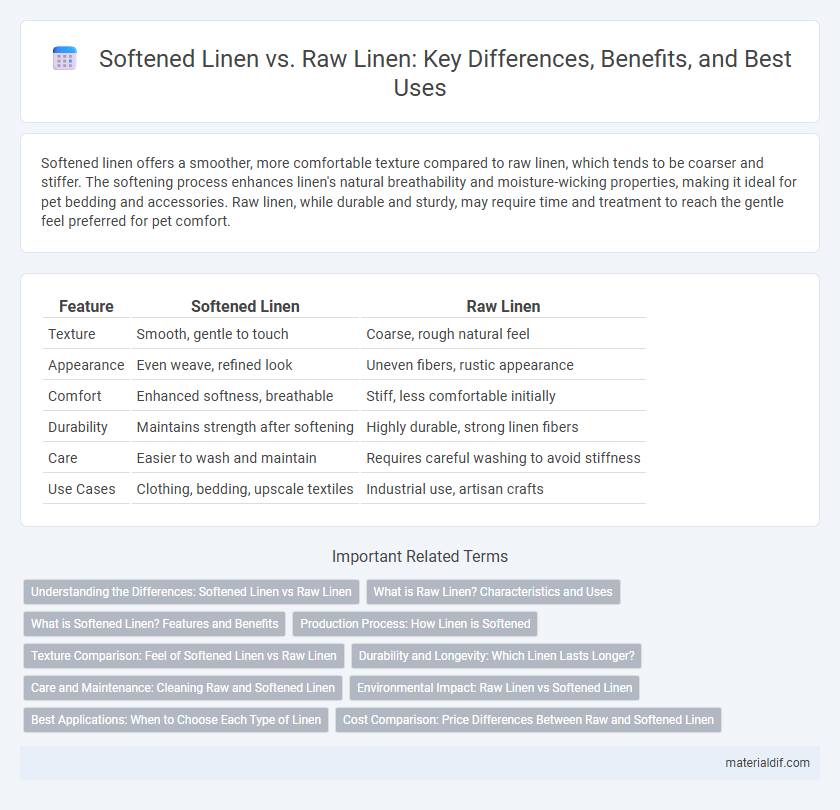Softened linen offers a smoother, more comfortable texture compared to raw linen, which tends to be coarser and stiffer. The softening process enhances linen's natural breathability and moisture-wicking properties, making it ideal for pet bedding and accessories. Raw linen, while durable and sturdy, may require time and treatment to reach the gentle feel preferred for pet comfort.
Table of Comparison
| Feature | Softened Linen | Raw Linen |
|---|---|---|
| Texture | Smooth, gentle to touch | Coarse, rough natural feel |
| Appearance | Even weave, refined look | Uneven fibers, rustic appearance |
| Comfort | Enhanced softness, breathable | Stiff, less comfortable initially |
| Durability | Maintains strength after softening | Highly durable, strong linen fibers |
| Care | Easier to wash and maintain | Requires careful washing to avoid stiffness |
| Use Cases | Clothing, bedding, upscale textiles | Industrial use, artisan crafts |
Understanding the Differences: Softened Linen vs Raw Linen
Softened linen undergoes a special finishing process that enhances its softness, making it more comfortable and less stiff compared to raw linen, which retains its natural coarse texture and firmness. Raw linen fibers are minimally processed, offering greater durability and a rustic appearance, while softened linen provides a smoother feel ideal for clothing and bedding. Choosing between softened and raw linen depends on the desired balance of texture, durability, and aesthetic appeal in textile applications.
What is Raw Linen? Characteristics and Uses
Raw linen is fabric made directly from flax fibers that have undergone minimal processing, retaining a coarse texture and natural stiffness. It features a distinct, earthy appearance with visible fiber irregularities, offering durability and breathability ideal for eco-friendly home decor and rustic fashion. Its robust nature makes raw linen suitable for upholstery, bags, and artisanal crafts where natural aesthetics and strength are prioritized.
What is Softened Linen? Features and Benefits
Softened linen is textiles made from flax fibers that have been treated to reduce stiffness, resulting in a smoother and more pliable fabric. This type of linen retains breathability and durability while offering enhanced comfort, making it ideal for clothing, bedding, and upholstery. The primary benefits include a gentler feel on the skin, easier maintenance, and reduced wrinkling compared to raw linen.
Production Process: How Linen is Softened
Softened linen undergoes a meticulous soaking and washing process that removes stiff pectin fibers, contrasting raw linen's untreated, rough texture. The fabric is then gently beaten or mechanically softened to enhance pliability and comfort, resulting in a smooth, breathable material ideal for clothing and bedding. Unlike raw linen, softened linen's improved tactile quality is achieved without compromising its natural strength and durability.
Texture Comparison: Feel of Softened Linen vs Raw Linen
Softened linen boasts a smoother, more pliable texture achieved through washing and treatment processes, making it gentle and comfortable against the skin. Raw linen retains its natural stiffness and coarser fibers, offering a rustic, tactile feel that becomes softer with use over time. The contrast in texture between softened and raw linen directly influences comfort and aesthetic appeal in textiles and home furnishings.
Durability and Longevity: Which Linen Lasts Longer?
Softened linen undergoes washing and finishing processes that enhance its softness but may slightly reduce fiber strength compared to raw linen, which retains its natural stiffness and original tensile durability. Raw linen fibers maintain higher resistance to wear and tear over extended use, making them more durable for heavy-duty applications. Choosing between softened and raw linen depends on the balance between initial comfort and long-term resilience, with raw linen generally offering greater longevity.
Care and Maintenance: Cleaning Raw and Softened Linen
Raw linen requires gentle washing with cold water and mild detergent to preserve its natural fibers and prevent shrinkage, while avoiding bleach and harsh chemicals that can weaken its texture. Softened linen, having undergone pre-washing or treatment, allows for more flexible cleaning options, including machine washing on a gentle cycle with warm water, and can benefit from occasional fabric softeners to maintain its smoothness. Both types should be air-dried or tumble dried on low heat to minimize wear and preserve durability.
Environmental Impact: Raw Linen vs Softened Linen
Raw linen has a lower environmental impact compared to softened linen due to minimal processing and chemical use, preserving natural fibers and reducing water and energy consumption. Softened linen undergoes additional treatments involving water, chemicals, and energy, increasing its environmental footprint. Choosing raw linen supports sustainability through reduced resource use and less pollution.
Best Applications: When to Choose Each Type of Linen
Softened linen is ideal for clothing and bedding where comfort and a smooth texture are prioritized, offering enhanced softness and reduced stiffness. Raw linen suits upholstery, curtains, and craft projects that benefit from its firm structure and natural, rustic appearance. Selecting linen depends on the balance between desired texture and durability for specific applications.
Cost Comparison: Price Differences Between Raw and Softened Linen
Softened linen generally carries a higher price point compared to raw linen due to the additional processing required to achieve its smooth texture. Raw linen is more affordable as it undergoes minimal treatment, preserving the natural fibers but often feeling stiffer. The cost difference reflects the value added by softening treatments, which enhance comfort and usability, making softened linen a preferred choice despite its premium price.
Softened Linen vs Raw Linen Infographic

 materialdif.com
materialdif.com